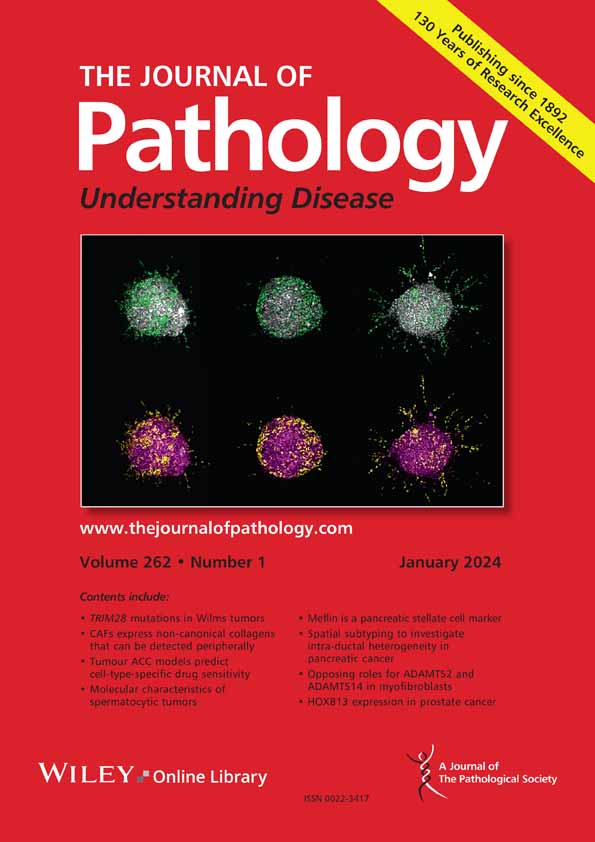Elias AT Koch, Christina Seidel, Ramona Erber, Michael Erdmann, Markus V Heppt, Stefan Schliep, Carola Berking, Jan Dörrie, Niels Schaft
下载PDF
{"title":"Enhanced diagnostic potential of CSPG4 in melanoma and nevi: a comparative study with PRAME, CDC7 and Ki67","authors":"Elias AT Koch, Christina Seidel, Ramona Erber, Michael Erdmann, Markus V Heppt, Stefan Schliep, Carola Berking, Jan Dörrie, Niels Schaft","doi":"10.1002/path.6450","DOIUrl":null,"url":null,"abstract":"<p>Chondroitin sulfate proteoglycan 4 (CSPG4) is a promising target for melanoma immunotherapy, but its expression in benign melanocytic lesions and its diagnostic value remain unexplored. This study assessed CSPG4 expression in benign nevi (BN), dysplastic nevi (DN), and superficial spreading melanomas (SSM), comparing it with PRAME (PReferentially expressed Antigen in MElanoma) and evaluating the cell division cycle 7-related protein kinase (CDC7) and the proliferation marker Ki67. Histological sections were stained using automated instruments, digitized, and analyzed using QuPath. Cohorts of BN, DN, and SSM were created, and positive cells/mm<sup>2</sup> and H-scores were determined. A total of 336 IHC stainings from 84 specimens were analyzed. CSPG4 expression was readily detected in SSM and was significantly stronger in DN (<i>p</i> = 0.005), with the highest intensity observed in BN (<i>p</i> < 0.001). PRAME showed the highest density of positive cells/mm<sup>2</sup> in SSM, was significantly reduced in DN (<i>p</i> < 0.001), and was lowest in BN (<i>p</i> < 0.001). Ki67 expression was strong in SSM, moderate in DN (<i>p</i> = 0.62), and low in BN (<i>p</i> = 0.008). CDC7 expression was most intense in DN, less in SSM (<i>p</i> = 0.39), and weakest in BN (<i>p</i> = 0.002). ROC AUC values for SSM versus DN and SSM versus BN were 0.764 and 0.921 for CSPG4, 0.85 and 0.889 for PRAME, 0.735 and 0.742 for Ki67, and 0.425 and 0.767 for CDC7. While PRAME was the most reliable marker for differentiating DN and SSM, CSPG4 was superior for distinguishing BN from SSM due to its high expression in BN. However, CSPG4-targeting therapies may trigger on-target/off-tumor effects due to its high expression in melanocytic nevi. © 2025 The Author(s). <i>The Journal of Pathology</i> published by John Wiley & Sons Ltd on behalf of The Pathological Society of Great Britain and Ireland.</p>","PeriodicalId":232,"journal":{"name":"The Journal of Pathology","volume":"267 1","pages":"69-78"},"PeriodicalIF":5.2000,"publicationDate":"2025-07-23","publicationTypes":"Journal Article","fieldsOfStudy":null,"isOpenAccess":false,"openAccessPdf":"https://pathsocjournals.onlinelibrary.wiley.com/doi/epdf/10.1002/path.6450","citationCount":"0","resultStr":null,"platform":"Semanticscholar","paperid":null,"PeriodicalName":"The Journal of Pathology","FirstCategoryId":"3","ListUrlMain":"https://pathsocjournals.onlinelibrary.wiley.com/doi/10.1002/path.6450","RegionNum":2,"RegionCategory":"医学","ArticlePicture":[],"TitleCN":null,"AbstractTextCN":null,"PMCID":null,"EPubDate":"","PubModel":"","JCR":"Q1","JCRName":"ONCOLOGY","Score":null,"Total":0}
引用次数: 0
引用
批量引用
Abstract
Chondroitin sulfate proteoglycan 4 (CSPG4) is a promising target for melanoma immunotherapy, but its expression in benign melanocytic lesions and its diagnostic value remain unexplored. This study assessed CSPG4 expression in benign nevi (BN), dysplastic nevi (DN), and superficial spreading melanomas (SSM), comparing it with PRAME (PReferentially expressed Antigen in MElanoma) and evaluating the cell division cycle 7-related protein kinase (CDC7) and the proliferation marker Ki67. Histological sections were stained using automated instruments, digitized, and analyzed using QuPath. Cohorts of BN, DN, and SSM were created, and positive cells/mm2 and H-scores were determined. A total of 336 IHC stainings from 84 specimens were analyzed. CSPG4 expression was readily detected in SSM and was significantly stronger in DN (p = 0.005), with the highest intensity observed in BN (p < 0.001). PRAME showed the highest density of positive cells/mm2 in SSM, was significantly reduced in DN (p < 0.001), and was lowest in BN (p < 0.001). Ki67 expression was strong in SSM, moderate in DN (p = 0.62), and low in BN (p = 0.008). CDC7 expression was most intense in DN, less in SSM (p = 0.39), and weakest in BN (p = 0.002). ROC AUC values for SSM versus DN and SSM versus BN were 0.764 and 0.921 for CSPG4, 0.85 and 0.889 for PRAME, 0.735 and 0.742 for Ki67, and 0.425 and 0.767 for CDC7. While PRAME was the most reliable marker for differentiating DN and SSM, CSPG4 was superior for distinguishing BN from SSM due to its high expression in BN. However, CSPG4-targeting therapies may trigger on-target/off-tumor effects due to its high expression in melanocytic nevi. © 2025 The Author(s). The Journal of Pathology published by John Wiley & Sons Ltd on behalf of The Pathological Society of Great Britain and Ireland.






 求助内容:
求助内容: 应助结果提醒方式:
应助结果提醒方式:


